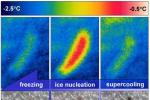Freeze-tolerant larvae of Drosophila melanogaster
Evolutionary adaptations for freeze-tolerance are considered to be highly complex. Among vertebrates, only a few species of amphibians and reptiles tolerate the formation of ice crystals in their body fluids. Freeze-tolerance is much more widespread in invertebrates, especially in overwintering insects. We have previously revealed some of the basic mechanisms of freeze-tolerance in subarctic drosophilid fly,Chymomyza costata (Kostal et al., PNAS USA 108, 13 041- 046).
In our new paper we show that the "tricks" learned form C. costata can be applied to a fruit fly of tropical origin with a weak innate capacity to tolerate even mild chilling. We found that surprisingly simple laboratory manipulations can change the chill susceptible insect to the freeze-tolerant one. Larvae of Drosophila melanogaster can then survive at subzero temperatures when approximately 50% of their body water turns to ice crystals. To achieve this goal, synergy of two fundamental prerequisites is required: (a) shutdown of larval development and all the chill sensitive processes linked to it by exposing larvae to low but above-lethal temperatures (quiescence), and (b) incorporating the free amino acid L-proline in tissues by feeding larvae a proline-augmented diet (cryopreservation).














